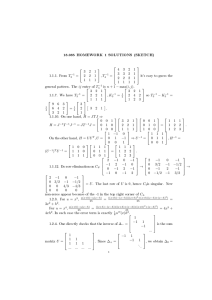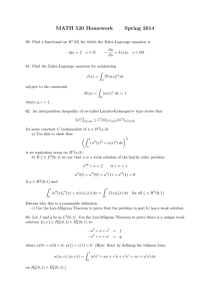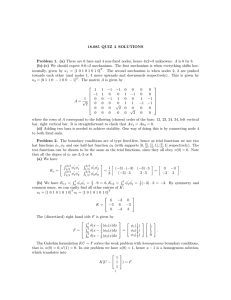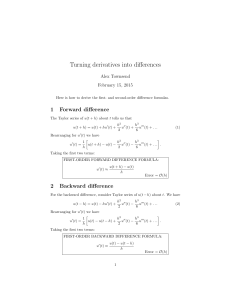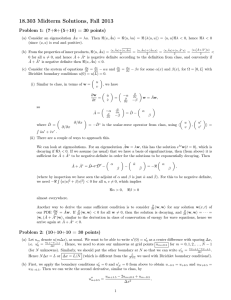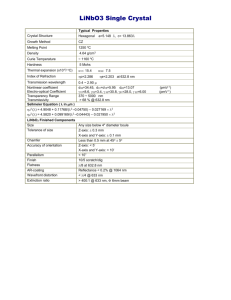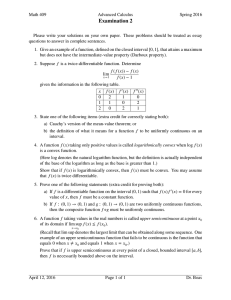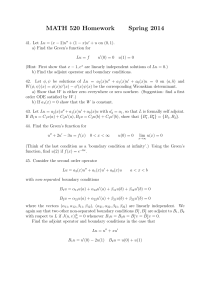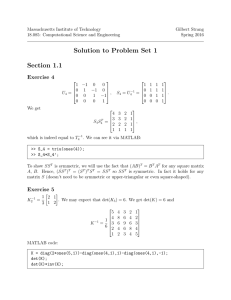Electronic Journal of Differential Equations, Vol. 2013 (2013), No. 08,... ISSN: 1072-6691. URL: or
advertisement
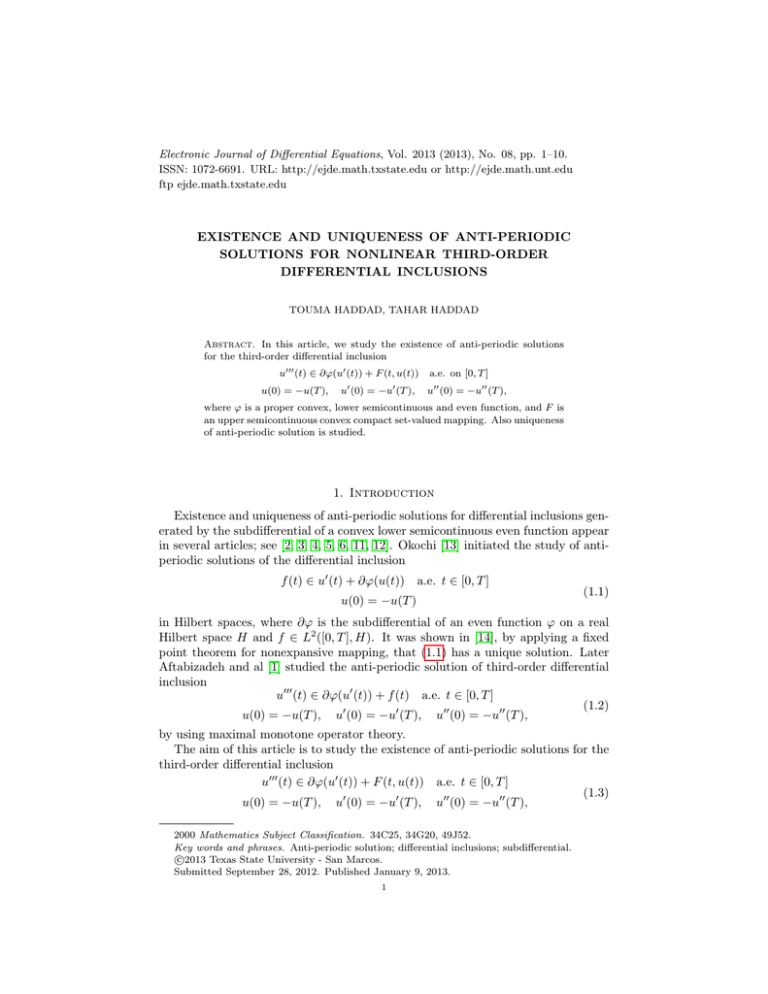
Electronic Journal of Differential Equations, Vol. 2013 (2013), No. 08, pp. 1–10.
ISSN: 1072-6691. URL: http://ejde.math.txstate.edu or http://ejde.math.unt.edu
ftp ejde.math.txstate.edu
EXISTENCE AND UNIQUENESS OF ANTI-PERIODIC
SOLUTIONS FOR NONLINEAR THIRD-ORDER
DIFFERENTIAL INCLUSIONS
TOUMA HADDAD, TAHAR HADDAD
Abstract. In this article, we study the existence of anti-periodic solutions
for the third-order differential inclusion
u000 (t) ∈ ∂ϕ(u0 (t)) + F (t, u(t))
u(0) = −u(T ),
u0 (0) = −u0 (T ),
a.e. on [0, T ]
u00 (0) = −u00 (T ),
where ϕ is a proper convex, lower semicontinuous and even function, and F is
an upper semicontinuous convex compact set-valued mapping. Also uniqueness
of anti-periodic solution is studied.
1. Introduction
Existence and uniqueness of anti-periodic solutions for differential inclusions generated by the subdifferential of a convex lower semicontinuous even function appear
in several articles; see [2, 3, 4, 5, 6, 11, 12]. Okochi [13] initiated the study of antiperiodic solutions of the differential inclusion
f (t) ∈ u0 (t) + ∂ϕ(u(t))
a.e. t ∈ [0, T ]
u(0) = −u(T )
(1.1)
in Hilbert spaces, where ∂ϕ is the subdifferential of an even function ϕ on a real
Hilbert space H and f ∈ L2 ([0, T ], H). It was shown in [14], by applying a fixed
point theorem for nonexpansive mapping, that (1.1) has a unique solution. Later
Aftabizadeh and al [1] studied the anti-periodic solution of third-order differential
inclusion
u000 (t) ∈ ∂ϕ(u0 (t)) + f (t) a.e. t ∈ [0, T ]
(1.2)
u(0) = −u(T ), u0 (0) = −u0 (T ), u00 (0) = −u00 (T ),
by using maximal monotone operator theory.
The aim of this article is to study the existence of anti-periodic solutions for the
third-order differential inclusion
u000 (t) ∈ ∂ϕ(u0 (t)) + F (t, u(t)) a.e. t ∈ [0, T ]
(1.3)
u(0) = −u(T ), u0 (0) = −u0 (T ), u00 (0) = −u00 (T ),
2000 Mathematics Subject Classification. 34C25, 34G20, 49J52.
Key words and phrases. Anti-periodic solution; differential inclusions; subdifferential.
c
2013
Texas State University - San Marcos.
Submitted September 28, 2012. Published January 9, 2013.
1
2
T. HADDAD, T. HADDAD
EJDE-2013/08
where ϕ : H →] − ∞, +∞] is a convex lower semicontinuous even function and
F : [0, T ]×H → 2H is an upper semicontinuous convex compact set-valued mapping
bounded above by L2 function. Furthermore, an existence and uniqueness result
when F is single-valued is also studied.
2. Preliminaries
Let H be a real Hilbert space with norm k · k and inner product h·, ·i. The
open ball centered at x with radius r is defined by Br (x) = {y ∈ H : ky − xk < r},
where Br (x) denotes its closure. For a proper lower semicontinuous convex function
ϕ : H →] − ∞, +∞], the set-valued mapping ∂ϕ : H → 2H defined by
∂ϕ(x) = {ξ ∈ H : ϕ(y) − ϕ(x) ≥ hξ, y − xi, ∀y ∈ H}
which is the subdifferential of ϕ. Let us recall a classical closure type lemma from
[7].
Lemma 2.1. Let H be a separable Hilbert space. Let ϕ be a convex lower semicontinuous function defined on H with values in ] − ∞, +∞]. Let (un )n∈N∪{∞} be
a sequence of measurable mappings from [0, T ] into H such that un → u∞ pointwise with respect to the norm topology. Assume that (ξn )n∈N is a sequence in
L2 ([0, T ], H) satisfying
ξn (t) ∈ ∂ϕ(un (t))
a.e. t ∈ [0, T ]
for each n ∈ N and converging weakly to ξ∞ ∈ L2 ([0, T ], H). Then we have
ξ∞ (t) ∈ ∂ϕ(u∞ (t))
a.e. t ∈ [0, T ].
Let us recall a useful result.
1,2
Lemma 2.2 ([15]). Let H be a real Hilbert space. Let u ∈ Wloc
(R, H) be 2T R 2T
periodic and satisfying 0 u(t)dt = 0, then
kukL2 ([0,2T ],H) ≤
T 0
ku kL2 ([0,2T ],H) .
π
3. Main results
We state and summarize some useful results for anti-periodic mappings that are
crucial for our purpose.
Proposition 3.1. Let H be a real Hilbert space. Let u ∈ W 3,2 ([0, T ], H) satisfying
u(0) = −u(T ), u0 (0) = −u0 (T ), u00 (0) = −u00 (T ), then the following inequalities
hold
√
(A1) kukC([0,T ],H) ≤ 2T ku0 kL2 ([0,T ],H) ;
(A2) kukL2 ([0,T ],H) ≤ Tπ ku0 kL2 ([0,T ],H) ;
√
(B1) ku0 kC([0,T ],H) ≤ 2T ku00 kL2 ([0,T ],H) ;
(B2) ku0 kL2 ([0,T ],H) ≤ Tπ ku00 kL2 ([0,T ],H) ;
(C1) ku00 kC([0,T ],H) ≤
√
ku000 kL2 ([0,T ],H) .
Rt
RT
Proof. (A1) Since u(t) = u(0) + 0 u0 (s)ds and u(t) = u(T ) − t u0 (s)ds, for all
t ∈ [0, T ], by adding these equalities, by anti-periodicity, we obtain
Z t
Z T
0
2u(t) =
u (s)ds −
u0 (s)ds, ∀t ∈ [0, T ].
T
2
0
t
EJDE-2013/08
EXISTENCE AND UNIQUENESS OF ANTI-PERIODIC SOLUTIONS
3
Hence we have
t
Z
ku0 (s)kds +
2ku(t)k ≤
T
Z
0
ku0 (s)kds =
T
Z
t
ku0 (s)kds,
∀t ∈ [0, T ],
0
and so, by Holder inequality
√
T 0
ku kL2 ([0,T ],H) .
2
kukC([0,T ],H) = sup ku(t)k ≤
t∈[0,T ]
(A2) For the sake of simplicity, we use the same notation u(t), t ∈ R, to denote
the anti-periodic extension of u(t), t ∈ [0, T ], such that
u(t + T ) = −u(t)
and u0 (t + T ) = −u0 (t),
for t ∈ R.
Then u is 2T -periodic function since
u(t + 2T ) = u(t + T + T ) = −u(t + T ) = u(t).
Also, since
Z 2T
T
Z
u(t)dt =
0
Z
2T
u(t)dt +
Z
0
T
T
Z
T
u(t)dt −
u(t)dt =
0
u(t)dt = 0,
0
so, by Lemma 2.2,
Z
T 2 2T 0
ku (t)k2 dt.
π2 0
0
Let us observe that ku(t)k2 and ku0 (t)k2 are T-periodic because ku(t + T )k2 =
k − u(t)k2 = ku(t)k2 and similarly ku0 (t + T )k2 = k − u0 (t)k2 = ku0 (t)k2 .
Hence we deduce that
Z 2T
Z T
Z 2T
Z T
2
2
0
2
ku(t)k dt = 2
ku(t)k dt and
ku (t)k dt = 2
ku0 (t)k2 dt.
Z
0
2T
ku(t)k2 dt ≤
0
0
0
Finally we get the required inequality
Z T
Z
T2 T 0
2
ku(t)k dt ≤ 2
ku (t)k2 dt.
π 0
0
Similarly, we prove (B1), (B2) and (C1), using u0 (0) = −u0 (T ), and u00 (0) = −u00 (T )
respectively.
The following result deal with convex compact valued perturbations of a thirdorder differential inclusion governed by subdifferential operators of convex lower
semicontinuous functions with anti-periodic boundary conditions. First, to simplify
we will assume that H = Rd .
Theorem 3.2. Let H = Rd , ϕ : H →] − ∞, +∞] be a proper, convex, lower
semicontinuous and even function. Let F : [0, T ] × H → 2H be a convex compact
set-valued mapping, measurable on [0, T ] and upper semicontinuous on H satisfying:
there is a function α(·) ∈ L2 ([0, T ], R+ ) such that
F (t, x) ⊂ Γ(t) := Bα(t) (0)
for all (t, x) ∈ [0, T ] × H.
Then the problem
u000 (t) ∈ ∂ϕ(u0 (t)) + F (t, u(t))
u(0) = −u(T ),
0
0
u (0) = −u (T ),
a.e. t ∈ [0, T ],
u00 (0) = −u00 (T ),
has at least an anti-periodic W 3,2 ([0, T ], H) solution.
4
T. HADDAD, T. HADDAD
EJDE-2013/08
Proof. Recall that a W 3,2 ([0, T ], H) function u : [0, T ] → H is a solution of the
problem under consideration if there exists a function h ∈ L2 ([0, T ]; H) such that
u000 (t) ∈ ∂ϕ(u0 (t)) + h(t)
h(t) ∈ F (t, u(t))
u(0) = −u(T ),
0
a.e. t ∈ [0, T ],
a.e. t ∈ [0, T ],
0
u00 (0) = −u00 (T ).
u (0) = −u (T ),
Let us denote by SΓ2 the set of all L2 ([0, T ]; H)-selection of Γ
SΓ2 := {f ∈ L2 ([0, T ], H) : f (t) ∈ Γ(t) a.e. t ∈ [0, T ]}.
By [2, Theorem 2.1], for all f ∈ SΓ2 , there is a unique W 3,2 ([0, T ], H) solution uf of
0
u000
f (t) ∈ ∂ϕ(uf (t)) + f (t)
uf (0) = −uf (T ),
u0f (0)
=
a.e. t ∈ [0, T ],
−u0f (T ),
u00f (0) = −u00f (T ),
such that
ku000
f kL2 ([0,T ],H) ≤ kf kL2 ([0,T ],H) .
For each f ∈
SΓ2 ,
(3.1)
let us define the set-valued mapping
Ψ(f ) := {g ∈ L2 ([0, T ], H); g(t) ∈ F (t, uf (t))
a.e. t ∈ [0, T ]}.
Then it is clear that Ψ(f ) is a nonempty convex weakly compact subset of SΓ2 , here
the nonemptiness follows from [10, theorem VI.4]. From the above consideration,
2
we need to prove that the convex weakly compact set-valued mapping Ψ : SΓ2 → 2SΓ
admits a fixed point. By Kakutani-Ky Fan fixed point theorem, it is sufficient to
prove that Ψ is upper semicontinuous when SΓ2 is endowed with the weak topology of
L2 ([0, T ], H). As L2 ([0, T ], H) is separable, SΓ2 is compact metrizable with respect
to the weak topology of L2 ([0, T ], H). So it turns out to check that the graph
gph(Ψ) is sequentially weakly closed in SΓ2 × SΓ2 . Let (fn , gn )n ∈ gph(Ψ) weakly
converging to (f, g) ∈ SΓ2 × SΓ2 . From the definition of Ψ, that means ufn is the
unique W 3,2 ([0, T ], H) solution of
0
u000
fn (t) ∈ ∂ϕ(ufn (t)) + fn (t)
ufn (0) = −ufn (T ),
u0fn (0)
=
a.e. t ∈ [0, T ],
−u0fn (T ),
u00fn (0) = −u00fn (T ),
with fn ∈ SΓ2 and gn (t) ∈ F (t, ufn (t)) a.e. t ∈ [0, T ]. Taking into account the
antiperiodicity of u00fn , u0fn and ufn , proposition 3.1 gives
√
T 000
00
kufn kC([0,T ],H) ≤
kufn kL2 ([0,T ],H) ,
2
√
T T 000
ku0fn kC([0,T ],H) ≤
kufn kL2 ([0,T ],H) ,
2π
√
T 2 T 000
kufn kL2 ([0,T ],H) .
kufn kC([0,T ],H) ≤
2π 2
for all n ≥ 1. Using the estimate (3.1), we have
ku000
fn kL2 ([0,T ],H) ≤ kfn kL2 ([0,T ],H) ≤ kαkL2 ([0,T ],R) < +∞.
We may conclude that
sup ku00fn kC([0,T ],H) < +∞,
n≥1
sup ku0fn kC([0,T ],H) < +∞,
n≥1
EJDE-2013/08
EXISTENCE AND UNIQUENESS OF ANTI-PERIODIC SOLUTIONS
5
sup kufn kC([0,T ],H) < +∞.
n≥1
By extracting suitable subsequences, we may assume that (u000
fn ) converges weakly
2
2
00
in L ([0, T ], H) to a function γ ∈ L ([0, T ], H) and (ufn ) converges pointwise to a
function w, namely
Z t
00
00
w(t) := lim ufn (t) = lim (ufn (0) +
u000
fn (s)ds)
n→+∞
n→+∞
0
Z t
= lim u00fn (0) +
γ(s)ds, ∀t ∈ [0, T ].
n→+∞
0
Then
Z t
v(t) := lim u0fn (t) = lim (u0fn (0) +
u00fn (s)ds)
n→+∞
n→+∞
0
Z t
= lim u0fn (0) +
w(s)ds, ∀t ∈ [0, T ].
n→+∞
0
So we have
Z t
u(t) := lim ufn (t) = lim (ufn (0) +
u0fn (s)ds)
n→+∞
n→+∞
0
Z t
= lim ufn (0) +
v(s)ds, ∀t ∈ [0, T ].
n→+∞
0
We conclude that u ∈ W 3,2 ([0, T ], H) with u0 = v, u00 = w and u000 = γ and
satisfying the anti-periodic conditions u(0) = −u(T ), u0 (0) = −u0 (T ) and u00 (0) =
−u00 (T ). Furthermore, we see that u0fn converges pointwise to u0 and u000
fn converges
000
2
to u with respect to the weak topology of L ([0, T ], H). Combining these facts
and applying Lemma 2.1 to the inclusion
0
u000
fn (t) − fn (t) ∈ ∂ϕ(ufn (t))
a.e. t ∈ [0, T ]
it yields
u000 (t) − f (t) ∈ ∂ϕ(u0 (t))
a.e. t ∈ [0, T ].
By uniqueness [1, Theorem 2.1], we have u = uf . Further using the inclusion
gn (t) ∈ F (t, ufn (t))
a.e. t ∈ [0, T ]
and invoking the closure type Lemma in [10, theorem VI.4], we have
g(t) ∈ F (t, uf (t))
a.e. t ∈ [0, T ].
We may then applying the Kakutani-Ky Fan fixed point theorem to the set-valued
mapping Ψ to obtain some f ∈ SΓ2 such that f ∈ Ψ(f ) or
f (t) ∈ F (t, u(t))
a.e. t ∈ [0, T ].
This means that
u000 (t) ∈ ∂ϕ(u0 (t)) + f (t)
f (t) ∈ F (t, u(t))
u(0) = −u(T ),
The proof is complete.
0
a.e. t ∈ [0, T ],
a.e. t ∈ [0, T ],
0
u (0) = −u (T ),
u00 (0) = −u00 (T ).
6
T. HADDAD, T. HADDAD
EJDE-2013/08
A more general version of the preceding result is available by introducing some
inf-compactness assumption [2] on the function ϕ.
Theorem 3.3. Let H be a separable Hilbert space, ϕ : H → [0, +∞] be a proper,
convex, lower semicontinuous and even function satisfying: ϕ(0) = 0 and for each
β1 , β2 > 0, the set {x ∈ D(ϕ) : kxk ≤ β1 , ϕ(x) ≤ β2 } is compact. Let F :
[0, T ] × H → 2H be a convex compact set-valued mapping, measurable on [0, T ] and
upper semicontinuous on H satisfying: there is α(·) ∈ L2 ([0, T ], R+ ) such that
F (t, x) ⊂ Γ(t) := Bα(t) (0)
∀(t, x) ∈ [0, T ] × H
Then the problem
u000 (t) ∈ ∂ϕ(u0 (t)) + F (t, u(t))
0
u(0) = −u(T ),
0
u (0) = −u (T ),
a.e. t ∈ [0, T ],
u00 (0) = −u00 (T ),
has at least an anti-periodic W 3,2 ([0, T ], H) solution.
Proof. Using the notation of the proof of Theorem 3.2, we have
0
u000
fn (t) − fn (t) ∈ ∂ϕ(ufn (t))
a.e. t ∈ [0, T ],
for every fn ∈ SΓ2 . The absolute continuity of ϕ(u0fn (·)) and the chain rule theorem
[9], yield
d
00
00
hu000
ϕ(u0fn (t)),
fn (t), ufn (t)i − hfn (t), ufn (t)i =
dt
for every fn ∈ SΓ2 , so that
Z T
Z T
d
00
00
ϕ(u0f (t))dt.
+∞ > sup
|hu000
(t),
u
(t)i
−
hf
(t),
u
(t)i|dt
=
sup
n
fn
fn
n
n
dt
n≥1 0
n≥1 0
Further applying the classical definition of the subdifferential to convex function ϕ
yields
0 = ϕ(0) ≥ ϕ(u0fn (t)) + h0 − u0fn (t), u000
fn (t) − fn (t)i
or
0 ≤ ϕ(u0fn (t)) ≤ hu0fn (t), u000
fn (t) − fn (t)i.
Hence
sup |ϕ(u0fn )|L1R ([0,T ]) < +∞.
n≥1
For all t ∈ [0, T ], we have
ϕ(u0fn (t))
=
ϕ(u0fn (0))
t
Z
+
0
d
ϕ(u0fn (s))ds ≤ ϕ(u0fn (0)) + sup |ϕ(u0fn )|L1R ([0,T ]) .
dt
n≥1
ϕ(u0fn (t))
Now we assert that
≤ β2 for every t ∈ [0, T ], here β2 is a positive constant.
Indeed for all t ∈ [0, T ], we have
ϕ(u0fn (0)) ≤ |ϕ(u0fn (t)) − ϕ(u0fn (0))| + ϕ(u0fn (t))
Z T
d
≤
| ϕ(u0fn (t))|dt + ϕ(u0fn (t)).
dt
0
Hence
ϕ(u0fn (0)) ≤ sup
n≥1
Z
T
|
0
d
1
ϕ(u0fn (t))|dt + sup
dt
T n≥1
Z
0
T
ϕ(u0fn (t))dt < +∞.
EJDE-2013/08
EXISTENCE AND UNIQUENESS OF ANTI-PERIODIC SOLUTIONS
7
Whence we have
β1 := sup sup ku0fn (t)k < +∞,
n≥1 t∈[0,T ]
β2 := sup sup ϕ(u0fn (t)) < +∞.
n≥1 t∈[0,T ]
(u0fn (t))
So that
is relatively compact with respect to the norm topology of H
using the inf-compactness assumption on ϕ. The proof can be therefore achieved
as Theorem 3.2 by invoking Lemma2.1 and a closure type lemma in [10, Theorem
VI-4].
Here is an existence and uniqueness result related to Theorem 3.3 when the
perturbation is single-valued.
Theorem 3.4. Let H be a separable Hilbert space, ϕ : H → [0, +∞] is a proper,
convex, lower semicontinuous and even function satisfying: ϕ(0) = 0 and for each
α, β > 0, the set {x ∈ D(ϕ) : kxk ≤ α, ϕ(x) ≤ β} is compact and f : [0, T ]×H → H
is a Carathéodory mapping satisfying :
(H1 ) kf (t, u) − f (t, v)k ≤ Lku − vk for all (t, u, v) ∈ [0, T ] × H × H, for some
positive constant L > 0.
(H2 ) There is a L2 ([0, T ]; R+ ) integrable function α : R → R+ such that kf (t, u)k ≤
π
α(t) for all (t, u) ∈ [0, T ] × H. If 0 < T < √
, then the inclusion
3
L
u000 (t) ∈ ∂ϕ(u0 (t)) + f (t, u(t))
u(0) = −u(T ),
0
0
u (0) = −u (T ),
a.e. t ∈ [0, T ],
u00 (0) = −u00 (T ),
admits a unique W 3,2 ([0, T ]; H)-anti-periodic solution.
Proof. Existence of at least one W 3,2 ([0, T ]; H)-anti-periodic solution is ensured by
Theorem 3.3. Indeed, we put F (t, u) := {f (t, u)} for all (t, u) ∈ [0, T ] × H, As f is
a Carathéodory function, then: u 7−→ f (t, u) is continuous, for almost all t ∈ [0, T ]
and t 7−→ f (t, u) is Lebesgue measurable, for all u ∈ H. More, by assumption;
there is a L2 ([0, T ]; R+ ) integrable function α(·) such that
kf (t, u)k ≤ α(t)
for all (t, u) ∈ [0, T ] × H.
Therefore, F satisfies hypotheses of Theorem 3.3.
To prove uniqueness, we assume that (u1 ) and (u2 ) are two solutions of the
inclusion under consideration.
0
u000
1 (t) ∈ ∂ϕ(u1 (t)) + f (t, u1 (t))
u1 (0) = −u1 (T ),
u01 (0)
=
−u01 (T ),
a.e. t ∈ [0, T ],
u001 (0) = −u001 (T ),
and
0
u000
2 (t) ∈ ∂ϕ(u2 (t)) + f (t, u2 (t))
u2 (0) = −u2 (T ),
u02 (0)
=
−u02 (T ),
a.e. t ∈ [0, T ],
u002 (0) = −u002 (T ).
For simplicity, let us set
v1 (t) = u000
1 (t) − f (t, u1 (t)),
v2 (t) =
u000
2 (t)
− f (t, u2 (t)),
∀t ∈ [0, T ],
∀t ∈ [0, T ].
Then we have
000
v1 (t) − v2 (t) = u000
1 (t) − u2 (t) − f (t, u1 (t)) + f (t, u2 (t)),
a.e. t ∈ [0, T ].
(3.2)
8
T. HADDAD, T. HADDAD
EJDE-2013/08
Multiplying scalarly (3.2) by (u01 − u02 ) and integrating on [0, T ] yields
T
Z
hv1 (t) − v2 (t), u01 (t) − u02 (t)idt
0
T
Z
000
0
0
hu000
1 (t) − u2 (t), u1 (t) − u2 (t)idt
=
(3.3)
0
Z
−
T
hf (t, u1 (t)) − f (t, u2 (t)), u01 (t) − u02 (t)idt
0
As v1 ∈ ∂ϕ(u01 ) and v2 ∈ ∂ϕ(u02 ) by monotonicity of (∂ϕ), (3.3) implies
Z T
000
0
0
hu000
1 (t) − u2 (t), u1 (t) − u2 (t)idt
0
Z
≥
(3.4)
T
hf (t, u1 (t)) −
f (t, u2 (t)), u01 (t)
−
u02 (t)idt.
0
By antiperiodicity, we have
Z T
000
0
0
hu000
1 (t) − u2 (t), u1 (t) − u2 (t)idt
0
= hu001 (T ) − u002 (T ), u01 (T ) − u02 (T )i − hu001 (0) − u002 (0), u01 (0) − u02 (0)i
Z T
−
hu001 (t) − u002 (t), u001 (t) − u002 (t)idt
0
Z
=−
T
ku001 (t) − u002 (t)k2 dt.
0
The inequality (3.4) gives
Z T
Z
ku001 (t) − u002 (t)k2 dt ≤
0
T
hf (t, u2 (t)) − f (t, u1 (t)), u01 (t) − u02 (t)idt
0
Z
≤L
T
ku1 (t) − u2 (t)k ku01 (t) − u02 (t)kdt.
0
By Holder’s inequality, we obtain
ku001 − u002 k2L2 ([0,T ],H) ≤ Lku1 − u2 kL2 ([0,T ],H) ku01 − u02 kL2 ([0,T ],H) .
Using the estimates (A1) and (A2) in proposition 3.1, we obtain
T
π2 0
ku1 − u02 k2L2 ([0,T ],H) ≤ L ku01 − u02 k2L2 ([0,T ],H)
2
T
π
or
ku01 − u02 k2L2 ([0,T ],H) ≤ L
T3 0
ku − u02 k2L2 ([0,T ],H) .
π3 1
It follows from the choice of T that ku01 − u02 k2L2 ([0,T ],H) = 0. By inequality (A2) in
lemma 2.2, we conclude that u1 (t) − u2 (t) = 0 for all t ∈ [0, T ]. This completes the
proof.
EJDE-2013/08
EXISTENCE AND UNIQUENESS OF ANTI-PERIODIC SOLUTIONS
9
4. Applications
Let Ω be a bounded domain in Rn with a smooth boundary ∂Ω. Let γ be a
maximal monotone operator on R such that γ = ∂j, where j : R → [0, +∞] is
proper, convex, lower semicontinuous and even with j(0) = 0. We are concerned
with the third-order boundary-value problem
−uttt (t, x) − ∆x ut (t, x) + f (t, u(t, x)) = 0
in [0, T ] × Ω,
∂ut
(4.1)
(t, x) ∈ γ(ut (t, x)) on [0, T ] × ∂Ω,
∂ν
u(0, x) = −u(T, x), ut (0, x) = −ut (T, x) utt (0, x) = −utt (T, x) in Ω,
Pn ∂ 2
∂
where ∂ν
denotes outward normal derivative, ∆x = i=1 ∂x
2 , and f : [0, T ] × R →
i
R is a Carathéodory function satisfying:
(i) |f (t, u) − f (t, v)| ≤ L|u − v| for all (t, u, v) ∈ [0, T ] × R2 , for some positive
constant L > 0,
(ii) There is an L2 ([0, T ]; R+ ) integrable function α : [0, T ] → R+ such that
|f (t, u)| ≤ α(t) for all (t, u) ∈ [0, T ] × R.
Let H = L2 (Ω), and define ϕ : H → [0, +∞] by
( R
R
1
| grad u|2 dx + ∂Ω j(u)dσ, if u ∈ H 1 (Ω) and j(u) ∈ L1 (∂Ω),
2
Ω
ϕ(u) =
+∞,
otherwise.
According to Brézis [8, Theorem 12], ϕ is proper, convex and lower semicontinuous
on H, with ∂ϕ(u) = −∆x u, and D(ϕ) = {u ∈ W 1,2 (Ω) : − ∂u
∂ν ∈ γ(u), a.e. on ∂Ω}.
We consider u = u(t, x) = u(t)(x) and we rewriter the problem (4.1) in the abstract
form
−u000 (t) + ∂ϕ(u0 (t)) + f (t, u(t)) 3 0
u(0) = −u(T ),
0
0
u (0) = −u (T ),
a.e. t ∈ [0, T ],
00
u (0) = −u00 (T ),
or
u000 (t) ∈ ∂ϕ(u0 (t)) + f (t, u(t))
u(0) = −u(T ),
0
0
u (0) = −u (T ),
a.e. t ∈ [0, T ],
u00 (0) = −u00 (T ).
We remark that ϕ(0) = 0, ϕ is even and that the inf-compactness condition on ϕ
holds because W 1,2 (Ω) is compactly imbedded in L2 (Ω). Then, we can applying
π
Theorem 3.4 to derive the existence of a solution to (4.1). If 0 < T < √
, then the
3
L
solution is unique.
Acknowledgments. The authors would like to thank the anonymous referees for
their careful and thorough reading of the original manuscript.
References
[1] A. R. Aftabizadeh, Y. K. Huang, N.H. Pavel; Nonlinear Third-Order Differential Equations
with Anti-Periodic Boundary Conditions and some Optimal Control Problems, J. Math.
Anal. Appl. 192, (1995), 266-293.
[2] S. Aizicovici, N. H. Pavel; Anti-Periodic Solutions to a class of Nonlinear Differential Equations in Hilbert Space, J. Fun. Anal. 99 (1991) 387-408.
[3] S. Aizicovici, N. H. Pavel; Anti-Periodic boundary value problems for higher order differential
equations in Hilbert spaces, Nonlinear Anal.18 (1992) 253-267.
10
T. HADDAD, T. HADDAD
EJDE-2013/08
[4] S. Aizicovici, N. H. Pavel; On class of second order anti-periodic boundary value problem, J.
Math. Appl. 171 (1992) 301-320.
[5] S. Aizicovici, N. H. Pavel, I. I. Vrabie; Anti-Periodic Solutions to Strongly Nonlinear Evolutions Equations in Hilbbert Space, Analele Stiintifice Ale Universitatii ”A.I.Cuza” Iasi, Tomul
XIV, s.I.a. Matematica, 1998.
[6] C. Castaing, T. Haddad; Relaxation and Bolza Problem Involving a Second Order Evolution
Inclusion, Yokohama Publishers, Volum 9, Number 2, 2008, 141-159.
[7] C. Castaing, P. Raynaud de Fitte, A. Salvadori; Some variational convergence results with
application to evolution inclusions, Adv. Math. Econ, 8 (2006), 33-73.
[8] H. Brézis; Monotonicity methods in Hilbert space and some applications to nonlinear partial
differential equations, Contribution to Nonlinear Functional Analysis, Acadimic press, New
York, 1971, pp. 101-156.
[9] H. Brézis; Opérateurs Maximaux Monotones et Semi-Groupes de Contractions dans les Espaces de Hilbert, North-Holland, Amsterdam, 1973.
[10] C. Castaing, M. Valadier; Convex analysis and measurable multifunctions, Lectures Notes in
Mathematics, Vol. 580, Springer-Verlag, Berlin (1977).
[11] J. F Couchouron, R. Precup; Anti-periodic solution for second order differential inclusions,
Electron. J. Differential Equations 2004 (2004) 1-17.
[12] A. Haraux; Anti-periodic solutions of some nonlinear evolution equations, Manuscripta.
Math. 63 (1989) 479-505.
[13] H. Okochi; On the existence of periodic solution of some nonlinear abstract parabolic equations, J. Math. sOC. Japon 40 (1988) 541-553.
[14] H. Okochi; On the existence of anti-periodic solutions to nonlinear evolutions equations
associated with odd subdifferential operators, J. Funct. Aal. 90 (1990) 246-258.
[15] P. Souplet; Optimal uniqueness condition for the anti-periodic solutions of some nonlinear
parabolic equations, Nonlinear Analysis, Theory, Methods and Applications, Vol. 32, No. 2,
pp. 279-286, 1998.
Touma Haddad
Département de Mathématiques, Faculté des Sciences, Université de Jijel, B.P. 98,
Algérie
E-mail address: touma.haddad@yahoo.com
Tahar Haddad
Laboratoire LMPA, Faculté des Sciences, Université de Jijel, B.P. 98, Algérie
E-mail address: haddadtr2000@yahoo.fr
